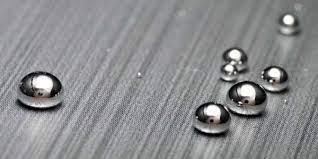Heavy metal contamination in surface water and groundwater is a global concern. Heavy metals may pose chronic and even acute health hazards to living organisms, including humans. Industrial wastewater, mining activities, and leachate from solid wastes are some causes of heavy metal pollution in water bodies. Among these sources, leachate from landfills have elicited increasing concern due to their potential to pollute groundwater severely.
Landfill leachate is a percolated liquid flowing out of a pile of garbage containing suspended, dissolved, and extracted materials produced when rainwater or runoff infiltrates wastes. Landfill leachate contains various heavy metals, such as Hg, Pb, Zn, Cr, Mg, and Cd, with high concentration. The World Health Organization set 3, 50, 1, 100, and 10 μg L−1 as the standards for the maximum level of Cd, Cr, Hg, Mn, and Pb in wastewater. If not handled properly, leachate can pollute groundwater and pose risks to human health.
Mercury (Hg) is one of the most toxic heavy metals, and it has become a worldwide concern because it has been found in groundwater in landfill areas with a concentration of approximately 0.36–3.01 μg L−1. Apart from the Hg content of groundwater in landfill areas, high salinity levels were also measured in leachate and groundwater due to seawater intrusion. Mangimbulude et al. (2016)indicated that the groundwater along Keputih landfill in Indonesia is contaminated by leachate and seawater intrusion with a salinity level of approximately 0.26–6.5‰. High salinity levels will decrease the quality of groundwater and disrupt the groundwater treatment process. In addition, high salinity will disrupt the natural bioremediation process.
Bioremediation is one of the effective biotechnologies used in heavy metal removal; it requires simple maintenance and operation and can be used in large areas, particularly sanitary landfills, under several conditions. The utilization of microbial metabolism plays a significant role in biotechnology. Some microorganisms can produce enzymes to remove heavy metals from contaminated areas. Indigenous microorganisms isolated from contaminated environments exhibit a resilient and efficient capability to remove pollutants.
The current research aims to determine (i) heavy metal content in non-active sanitary landfill leachate, located in Keputih, Surabaya, (ii) the resistance of bacteria isolated from non-active sanitary landfill leachate to various heavy metals, and (iii) the effect of salinity level on the Hg removal of the most resilient isolated bacterium as a developmental strategy for the future remediation of heavy metals in contaminated areas.
Based on our research, leachate samples were collected from two monitoring wells (MWs) of a non-active sanitary landfill in Keputih, Surabaya, Indonesia. The pH and temperature of the leachate were ranged 7.5–8.2 and 31 ± 1.4 °C, respectively. BOD, COD, TKN, and TP concentrations were 134 ± 5, 258 ± 14, 25.8 ± 1.4, and 1.82 ± 0.14 mg L−1, respectively. Heavy metals, except for Mn (0.004 ± 0.0 mg L−1), were not detected. Four dominant bacteria were isolated from the leachate and then were identified as Vibrio damsela, P. aeruginosa, Pseudomonas stutzeri, and P. fluorescens, respectively a similarity percentage of more than 90%. And the, all the isolated bacteria were exposed to various heavy metals to determine the response of bacteria.
The result showed that the minimum inhibitory concentration (MIC) of all the bacteria in Fe, Mn, and Cu was > 20 mg L−1. The MIC of V. damsela was 5 mg L−1 for Hg and > 20 mg L−1for Cd, Pb, Mg, and Zn. For P. aeruginosa, MIC was > 20 mg L−1 for Cd, Pb, Mg, and Zn and 10 mg L−1 for Hg. Meanwhile, the MIC of P. stutzeri was > 20 mg L−1 for Pb, Mg, and Zn and 5 mg L−1 for Hg and Cd. The MIC of P. fluorescens for Hg, Pb, Mg, and Zn was 5, 5, 15, and 20 mg L−1, respectively, and that for Cd was > 20 mg L−1. From the MIC results, Hg is the most toxic heavy metal.
The effect of various salinity levels on the removal of Hg by P. aeruginosa FZ-2 was further investigated. The removal of Hg in freshwater (0‰) is lower than in other salinity levels, with the removal efficiency reaching 54%. In marginal water (10‰), brackish water (20‰), and saline water (30‰), the removal efficiencies are >99, 94, and 89%, respectively. Based on the result, salinity exerts a significant positive effect on P. aeruginosa FZ-2 in removing Hg.
Understanding the response of bacteria related to heavy metal exposure is required before applying bioremediation techniques. Bioremediation can exhibit good performance when the bacteria used as bioremediation agent can grow well in heavymetal-polluted areas. Bacteria show the capability to adsorb and accumulate heavy metal ions with high adsorption capacity. The bioremediation of leachate by bacteria is considered one of the biotechnology approaches that is environment-friendly, cost-effective, and safe for decontaminating leachate. The resistance level of bacteria strongly influences this process to heavy metals. This research approach will help identify the type of bacteria that is highly resistant to heavy metals with other environmental factors.
Author: Muhammad Fauzul Imron, S.T., M.T.
Further details available at:
https://sustainenvironres.biomedcentral.com/articles/10.1186/s42834-021-00088-6





